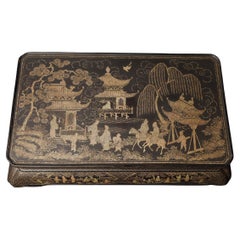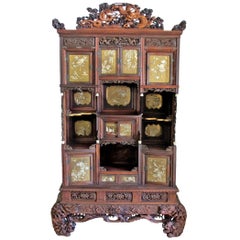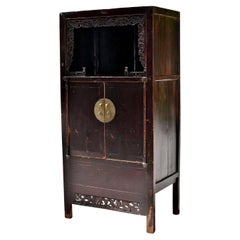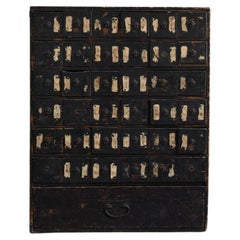Japanese Furniture
10
to
2
4
3
10
10
10
10
81
138
38
94
32
3
3
1
4
3
1
1
1
8
5
2
2
2
12,916
97
75
63
31
Period: 18th Century and Earlier
Place of Origin: Japanese
Ming Dynasty Period Scholar's Garden: Mother-of-Pearl Inlaid Lacquer Kang Table
Located in Fukuoka, JP
Behold the splendor of Ming Dynasty artistry with this magnificent Kang table (SKU: ZD71), an exceptional piece of furniture from the 16th to 17th century. This table is not merely a...
Category
16th Century Ming Antique Japanese Furniture
Materials
Wood
Edo period Japanese medicine chest
By Japanese Studio
Located in CARLTON, AU
This is a very old and rare Japanese tooling storage tansu. It was made early
Edo period of Japanese cedar and its handle was made of iron. Its ultimate...
Category
17th Century Edo Antique Japanese Furniture
Materials
Cedar
Antique Japanese Rare Early Edo Era (dated 1675!) Document Tansu 30"H
Located in Portland, OR
Available from Shogun's Gallery in Portland, Oregon for over 40 years specializing in Asian Arts & Antiques.
This is a very rare 350 year old antique Japanese...
Category
Late 17th Century Antique Japanese Furniture
Materials
Wrought Iron
Japanese Antique Gifu chôba’dansu 帳場箪笥 (merchant's document cabinet)
Located in Amsterdam, NL
Amazing wooden Gifu chôba’dansu (merchant's document cabinet) with sturdy iron hardware and a well-hidden secret compartment. Fully restored, cleaned and w...
Category
Mid-18th Century Antique Japanese Furniture
Materials
Iron
Antique Japanese Karuma Tansu
Located in Los Angeles, CA
19th c. Kuruma tansu - cabinet on wheels. These were used to store belongings and the wheels made them easy to move outside during house fires, which were...
Category
18th Century Edo Antique Japanese Furniture
Materials
Wood
17th Century Japanese Export Lacquer Cabinet with Depiction the Dutch Tradepost
Located in Amsterdam, NL
A highly important Japanese export lacquer cabinet with depiction of the Dutch East India Company tradepost Deshima and the annual Dutch delegation on its way to the Shogun in Edo
Edo period, circa 1660-1680
H. 88 x W. 100.5 x D. 54 cm
This cabinet includes a later European japanned stand, but also a modern powder-coated steel frame.
The latter can be designed and added to your specific needs.
The sides and front of the rectangular two-door cabinet are embellished in gold and silver hiramaki-e and takamaki-e on a black roiro lacquer ground with a continuous design. The two doors depict a long procession of numerous figures travelling on foot and horseback along buildings and a pagoda into a mountainous landscape. This is the annual court journey, Hofreis, of the Dutch from Nagasaki to the Shogun’s court in Edo. Three horseback riders are dressed as Dutch merchants and a fourth figure, probably het Opperhoofd, is seen inside a palanquin, norimon. Just about to cross the bridge, two men are carrying a cabinet like the present one.
Many Japanese figures on either side of the procession are engaged in various activities; some play musical instruments on board of small boats, others are fishing; figures inside buildings are depicted playing go, and farmers are tending to their rice paddocks. The upper part of the right door shows a large mansion, probably the local daimyo’s castle, with men kneeling before a man in the central courtyard.
The court journey fits in with the foreign policy of the shogunate which accorded a role to the VOC alongside China, Korea, and the Ryukyu Islands who also had to pay tribute. However, the VOC employees were traders, having low status in Japan’s social hierarchy, and they were received with less deference than were the state embassies from Korea and the Ryukyu Islands. Nevertheless, the contacts with the Dutch were a welcome source of information to the Shogun about Europe and European science and technology.
The left side of the cabinet depicts, in mirror image, a rare view of the artificial fan-shaped Deshima Island, the trading post for the Dutch in Japan. The island, where the Dutch flag flies, is surrounded by small Japanese boats and an anchored three-masted fluyt (cargo ship), flying Dutch flags, with on the stern the VOC monogram. On the bottom right a busy street of Nagasaki is shown, bordered by shops and leading up to the stone bridge. On the island the trees are beautifully painted, two cows can be seen, and the flagpole, all in very fine detail. Dutchmen and enslaved Malay are visible outside the buildings and two Japanese figures, probably guards, sit in a small hut in the centre.
A maximum of fifteen to twenty Dutchmen lived on the island at any time and soldiers or women were not allowed. Restrictions on Deshima were tight, and the merchants were only allowed to leave the island by special permission. The Opperhoofd had to be replaced every year, and each new Opperhoofd had to make a court journey to pay tribute, present gifts, and to obtain permission to Margaret Barclay eep on trading. In the distance, many birds fly above the hills and a four-story pagoda can be seen. The right side of the cabinet is painted with other horse riders and their retinue journeying through mountains.
The pair of doors to the front open to reveal ten rectangular drawers. The drawers are decorated with scenes of birds in flight and landscapes with trees and plants. The reverse of the left door with two thatched buildings, one with a ladder, underneath a camelia tree with large blooms; the right door with a three-story pagoda nestled among trees and both doors with a flying phoenix, ho-oo bird. The cabinet, with elaborately engraved gilt copper mounts, hinges, lock plates and brass handles, is raised on an 18th-century English japanned wood stand.
A pair of large cabinets...
Category
17th Century Edo Antique Japanese Furniture
Materials
Copper, Gold
Maki-E Four-Sided Tea Shelf / Japanese Antique / 18th Century
Located in Kyoto-shi, Kyoto
An old tea shelf from around the 18th century with maki-e painted on all four sides. The lacquer work of this product is a delicate artwork, and the composit...
Category
18th Century Antique Japanese Furniture
Materials
Wood
Portuguese-colonial Japanese Namban lacquer Vargueno Cabinet, circa 1600
Located in Amsterdam, NL
A Portuguese-colonial Japanese Namban lacquer vargueno cabinet
Momoyama period, circa 1600
H. 43 x W. 64.5 x D. 36 cm
Wood, black lacquered and deco...
Category
Early 1600s Antique Japanese Furniture
Materials
Gold, Brass
Rare Charming 17th Century Japanese Lacquer Cabinet with Gilt-Bronze Mounts
Located in Amsterdam, NL
A fine Japanese pictoral style lacquer cabinet with gilt-metal mounts
Kyoto, Edo period, 1670-1690
Decorated in Japanese relief lacquer work, black lacquer ground decorated...
Category
Late 17th Century Antique Japanese Furniture
Materials
Bronze
Japanese Lacquered Wood Table
Located in Hudson, NY
Japanese lacquered wood table
(in Chinese style) with m.o.p. inlay.
Category
Late 18th Century Antique Japanese Furniture
Related Items
Japanese Carved and Lacquered Shibayama Cabinet, Meiji Period
Located in San Francisco, CA
An elaborate and finely detailed carved wood, and gold lacquered Shibayama cabinet (Chigaidansu). Having beautifully applied semi-precious stone and ...
Category
19th Century Meiji Antique Japanese Furniture
Materials
Mother-of-Pearl, Wood
Chinese Antique Scholar's Cabinet with Carved Grapevine
Located in Somis, CA
This elegant antique cabinet has a "open light" feature on its top portion. The name came from its open design to allow the display of special things or easy access to objects and books that are frequently needed. Trimmed with a carved grapevine...
Category
19th Century Antique Japanese Furniture
Materials
Wood
Japanese Tansu Storage Chest (19th Century - Edo Period) Wabi Sabi
Located in London, GB
Japanese Tansu Storage Chest (Edo Period - 19th Century). Tansu are traditional portable wooden storage chests from Japan. In Japanese traditional houses...
Category
19th Century Edo Antique Japanese Furniture
Materials
Wood
Japanese Antique Kitchen Cabinet with Sliding Doors, Rattan and Glass Panels
Located in Yonkers, NY
An antique Japanese kitchen cabinet from the early 20th century with sliding doors, drawers, woven rattan accents and textured glass panels. C...
Category
Early 20th Century Japanese Furniture
Materials
Rattan, Glass, Wood
H 41.25 in W 30.25 in D 13.25 in
Small Tansu Cabinet
Located in Fulton, CA
Exotic wood Tansu cabinet with brass hardware. Beautiful wood-grain and brass mounts. Original Lock with key. I believe this to be Korean from the mid to...
Category
20th Century Japanese Furniture
Materials
Brass
19th Ctr. Apothecary Medicine Chest with 45 Drawers
Located in Kastrup, DK
A Chinese Qing Dynasty apothecary / pharmacy medicine chest.
Front in original red lacquer with 45 drawers (42 small drawers + 3 larger drawers at the bottom).
Each drawer with hand written Chinese calligraphy in black lacquer. These were used to store and organise Chinese herbs...
Category
Late 19th Century Qing Antique Japanese Furniture
Materials
Wood
Japanese Tansu Storage Cabinet with Sliding Doors, Meiji Periode
Located in Kastrup, DK
A Japanese Meiji period two-section tansu cabinet (also known as Mizuya Dansu) crafted in pine and elm burl.
The top section consist of sliding doors and drawers in elm wood. Lower ...
Category
Late 19th Century Meiji Antique Japanese Furniture
Materials
Iron
Antique Japanese Edo Era Early 1800's Gyoshobako Peddler's Tansu Chest 28"
Located in Portland, OR
Available from Shogun's Gallery in Portland, Oregon for Over 40 Years Specializing in Asian Arts & Antiques.
This tansu is around 200 year old. It is an antique Japanese gyoshobako-...
Category
Early 19th Century Antique Japanese Furniture
Materials
Wrought Iron
Apothecary Medicine Chest with 45 Drawers
Located in Kastrup, DK
A Chinese Qing Dynasty apothecary / pharmacy medicine chest.
Front in original red lacquer with 45 drawers (42 small drawers + 3 larger drawers at the bottom).
ach drawer with hand written Chinese calligraphy in black lacquer.
These were used to store and organise Chinese herbs...
Category
Late 19th Century Qing Antique Japanese Furniture
Materials
Wood
Japanese Taishō Tansu Chest in Isho-Dansu Style with Six Drawers and Safe
Located in Yonkers, NY
A Japanese Taisho period single section tansu clothing chest from the early 20th century in Isho-dansu style, with six drawers, safe, carrying handles and dark patina. Created in Japan during the Taisho period in the early years of the 20th century, this wooden Isho-dansu clothing chest features a linear silhouette perfectly complimented by a dark finish. The organized façade showcases six drawers (three large ones followed by two medium size and a smaller one), each fitted with iron hardware made of C-scroll handles and a central lock. The lower right section presents the safe, which opens to reveal additional drawers. Tansus were portable chests...
Category
Early 20th Century Taisho Japanese Furniture
Materials
Iron
Japanese Tansu with White Sliding Doors
Located in Somis, CA
A most charming Tansu. The sliding doors are covered in white Japanese hand made rice paper in traditional shell pattern and fitted with oval bronze hardware. Behind the doors a larg...
Category
20th Century Japanese Furniture
Materials
Bamboo, Wood, Paper
Large Two Section Japanese Kitchen Tansu, Late 19th Century
Located in Savannah, GA
Large two section Japanese Kitchen Tansu, late 19th century. Interior has been modified for bar use (glass shelves). Part of the back bottom sec...
Category
Late 19th Century Antique Japanese Furniture
Materials
Elm
Previously Available Items
Edo Period Imari Porcelain Plate with Dragon Motive
Located in Fukuoka, JP
A Very Fine and Rare Hand Painted Imari Porcelain Plate
This very fine and rare hand-painted Imari porcelain plate is a stunning example of Japanese craftsmanship. It is dated to th...
Category
18th Century Edo Antique Japanese Furniture
Materials
Ceramic, Porcelain
Very Rare Japanese Black Antique Drawer / 1750-1900 / Chest of Drawers / Storage
Located in Sammu-shi, Chiba
We have a unique Japanese aesthetic sense.
And only we can introduce unique items through our purchasing channels in Japan and the experience we have gained so far, in such a way that no one else can imitate.
This is a Japanese wooden drawer.
It was made from the late Edo period to the Meiji period (1750-1900).
A drawer for storing Chinese medicine.
It was used in the drugstore at that time.
Over the years, the atmosphere has changed to a very good one.
It's very cool.
I don't think I need a lot of explanation.
It promises to create a great atmosphere whether you put it at the entrance or in front of a white wall.
There are many worm-eaten marks because it contains Chinese medicine.
Please forgive me because wood powder will come out from the worm-eaten hole due to vibration during transportation.
Most Japanese drawers...
Category
Late 18th Century Edo Antique Japanese Furniture
Materials
Cedar
H 27.96 in W 22.21 in D 8.86 in
Old Japanese Black Desk "1700s-1800s" Edo Period Antique Table or Low Table
Located in Sammu-shi, Chiba
We have an aesthetic sense peculiar to Japanese people.
And we introduce the unique items that only we can do, the route of purchasing in Japan, the experience value so far, and the way that no one can imitate.
This desk was made in the latter half of the Edo period (1700 to 1800) in Japan.
In old Japan, people used to sit on the floor to eat and study.
This is a desk mainly for studying and office work.
In the Edo period, there was a facility to teach study.
The name of the facility is called "Terakoya".
Here the children were learning to read and write.
Such a desk was also used there.
It is also used in stores.
It is made of cedar wood.
Sugi is a wood that has been used since ancient times in Japan.
It has been widely used in architecture and furniture.
And this is black and beautiful.
Probably black lacquer is applied.
In addition, Japan has a hearth culture.
In addition, soot such as braziers and candles adheres and turns black.
I think it was used in northern Japan, especially in cold regions.
There are only a few desks in the Edo period.
And there are fewer such beautiful black desks.
It's very rare.
Even Japanese people cannot easily find it.
Also, I think that we are the only shop that sells this even in 1st dibs.
Also as a confirmation item
Very old...
Category
Mid-18th Century Edo Antique Japanese Furniture
Materials
Cedar
H 10.24 in W 38.19 in D 13.59 in
Edo Period Japanese Antique Low Table / Coffee Table / Low Desk/Display Stand
Located in Sammu-shi, Chiba
We have an aesthetic sense peculiar to Japanese people.
And we introduce the unique items that only we can do, the route of purchasing in Japan, the experience value so far, and the...
Category
Late 18th Century Edo Antique Japanese Furniture
Materials
Other
H 9.18 in W 35.71 in D 14.41 in
Japanese Antique Drawer / Tansu Chest / Coffee Table/Wooden Box/Exhibition Stand
Located in Sammu-shi, Chiba
It is a wooden drawer from the late Edo period to the Meiji period (1750-1868) in Japan.
The wood is made of paulownia.
It is painted with red lacquer.
Soot adheres from above and...
Category
Late 18th Century Edo Antique Japanese Furniture
Materials
Other
H 21.07 in W 27.45 in D 15.67 in
Japanese Old Wooden Tray / Lacquered Tray from the Edo Period / Wabi-Sabi Art
Located in Sammu-shi, Chiba
We have an aesthetic sense peculiar to Japanese people.
And we introduce the unique items that only we can do, the route of purchasing in Japan, the experience value so far, and the ...
Category
18th Century Edo Antique Japanese Furniture
Materials
Oak
Old Japanese Desk '1700s-1800s' Edo Period Chestnut Antique Table or Low Table
Located in Sammu-shi, Chiba
We have an aesthetic sense peculiar to Japanese people.
And we introduce the unique items that only we can do, the route of purchasing in Japan, the experience value so far, and the...
Category
18th Century Edo Antique Japanese Furniture
Materials
Chestnut
H 10.56 in W 35.56 in D 14.38 in
Old Japanese Desk Edo Period '1700s-1800s' Zelkova Antique Table or Low Table
Located in Sammu-shi, Chiba
A desk made in the middle to late Edo period in Japan.
In old Japan, people used to sit on the floor to eat and study.
This is a desk mainly for studying and office work.
In the E...
Category
18th Century Edo Antique Japanese Furniture
Materials
Other
H 9.57 in W 35.6 in D 13 in
Black Wooden Box from the Edo Period '18th-19th Century' in Japan
Located in Sammu-shi, Chiba
Introducing valuable items that only I, a Japanese, can find.
A wooden box made in the Edo period.
It's simple, but it has a very nice atmosphere.
It is believed that it was made ...
Category
Mid-18th Century Edo Antique Japanese Furniture
Materials
Cedar
Japanese Cedar Tansu Chest of Drawers, Edo Period, Late 18th Century
Located in New York, NY
A seven-drawer Japanese Tansu chest in cedar and elm wood. Edo Period, circa 1780. Original trim and hardware. The outside is finished elm wood in two tones, and the drawers are made...
Category
1780s Edo Antique Japanese Furniture
Materials
Elm, Cedar
Japanese Ancient Hand-Carved Lotus Bowl on Stand, 18th Century or Earler
Located in South Burlington, VT
Japan, a handsome, ancient and hand-carved stone lotus bowl shape that balances beautifully a top a separate tapered pyramidal stone base. This ensemble ex...
Category
18th Century Edo Antique Japanese Furniture
Materials
Stone
H 22.5 in W 11.5 in D 11.5 in
Japanese Buddhist Offering Table, circa 17th Century
Located in Prahran, Victoria
Rare Japanese red and black lacquered Buddhist offering table decorated with gilded floral and butterfly motifs and applied incised gilt copper hardware, early Edo circa 1650.
Dim...
Category
Mid-17th Century Edo Antique Japanese Furniture
Materials
Copper
Read More
Chicago’s Pagoda Red Has a Spirited Mix of Asian Antiques and Bold New Art
For 25 years, gallerist Betsy Nathan has leveraged her keen eye and key connections to bring a unique selection of rare finds to the market.
12 Calming Spaces Inspired by Japanese Design
From cherry-blossom-adorned walls paired with glamorous lighting to wood-paneled ceilings above checkerboard-patterned chairs, these 12 spaces seamlessly blend Eastern and Western aesthetics.
Recently Viewed
View AllMore Ways To Browse
Chinese Woodwork
Wooden Panel China
Red Chinese Decor
Red Lacquer Decor
Chinese Gold Red Wood
Antique Asian Furniture Chests
Red Asian Chest
Chinese Elm Ming
Asian Chinese Rosewood
Asian Drawers Handle
Beijing Antique Furniture
Antique Asian Coffee Table
Antique Asian Coffee Tables
Asian Antique Coffee Table
Asian Scroll Table
Scroll Horse
Chinese Stand Hardwood
Tibetan Wood








